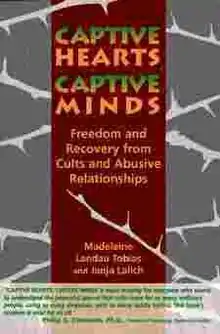Captive Hearts, Captive Minds
Captive Hearts, Captive Minds: Freedom and Recovery from Cults and Other Abusive Relationships is a study of cults and abusive relationships, by Madeleine Landau Tobias, Janja Lalich, Ph.D., and Michael Langone. It was published by Hunter House Publishers in 1994.
 Captive Hearts, Captive Minds | |
| Author | Madeleine Landau Tobias Janja Lalich Michael Langone |
|---|---|
| Country | United States |
| Language | English |
| Subject | Cults psychology |
| Publisher | Hunter House Publishers |
Publication date | April 1994 |
| Media type | Print (Hardcover and Paperback) |
| Pages | 304 |
| ISBN | 0-89793-144-0 |
| OCLC | 29319977 |
| 362.2 20 | |
| LC Class | BP603 .T62 1994 |
| Followed by | Cults in Our Midst Bounded Choice |
In her book Twisted Scriptures: Breaking Free from Churches that Abuse, Christian Countercult author Mary Alice Chrnalogar cites Captive Hearts, Captive Minds and adds a note that the book is "excellent for former New Agers".[1]
The work is extensively cited in Tourish and Wohlforth's On the Edge: Political Cults Left and Right, in their chapter on Marlene Dixon.[2]
Snow cites the work in his book, Deadly Cults: The Crimes of True Believers, to analyze predisposing factors that might make certain individuals more inclined than others to join cults.[3] Snow cites Lalich and Tobias again later in his work, while discussing the experience of a woman who had been counseled by a therapist that belonged to what Snow referred to as ". . . an intensely controlling psychoanalytical cult called the Sullivanians."[3]
Captive Hearts, Captive Minds is also cited by Philip Jenkins in his book Mystics and Messiahs: Cults and New Religions in American History, in the chapter "Overrun with Messiahs",[4] but it's not clear that he agrees with the authors' analysis.
As the title would suggest, Captive Hearts, Captive Minds falls squarely within the category of books whose authors adopt anti-cult movement theories and rhetoric concerning new religious movements, including the theory that participants in such movements are "victims" of "thought reform" or "mind control." This theory is not universally accepted by psychologists and other scholars of religion. Other theories concerning new religious movements attribute free will and informed choice to the participants, and challenge the captivity/abuse model put forward by the authors here.
See also
References
- Chrnalogar—, Mary Alice (2000). Twisted Scriptures: Breaking Free from Churches that Abuse. Zondervan. p. 260. ISBN 0-310-23408-5.
- Wohlforth, Tim; Dennis Tourish (2000). On the Edge: Political Cults Left and Right. M.E. Sharpe. p. 234. ISBN 0-7656-0639-9.
- Snow, Robert L. (2003). Deadly Cults: The Crimes of True Believers. Praeger/Greenwood. pp. 5, 129, 138, 196. ISBN 0-275-98052-9.
- Jenkins, Philip (2000). Mystics and Messiahs: Cults and New Religions in American History. Oxford University Press. p. 241. ISBN 0-19-512744-7.
External links
- Review of the book by exit counselor Carol Giambalvo, Cultic Studies Journal, Psychological Manipulation and Society Vol. 10, No. 3, 1993